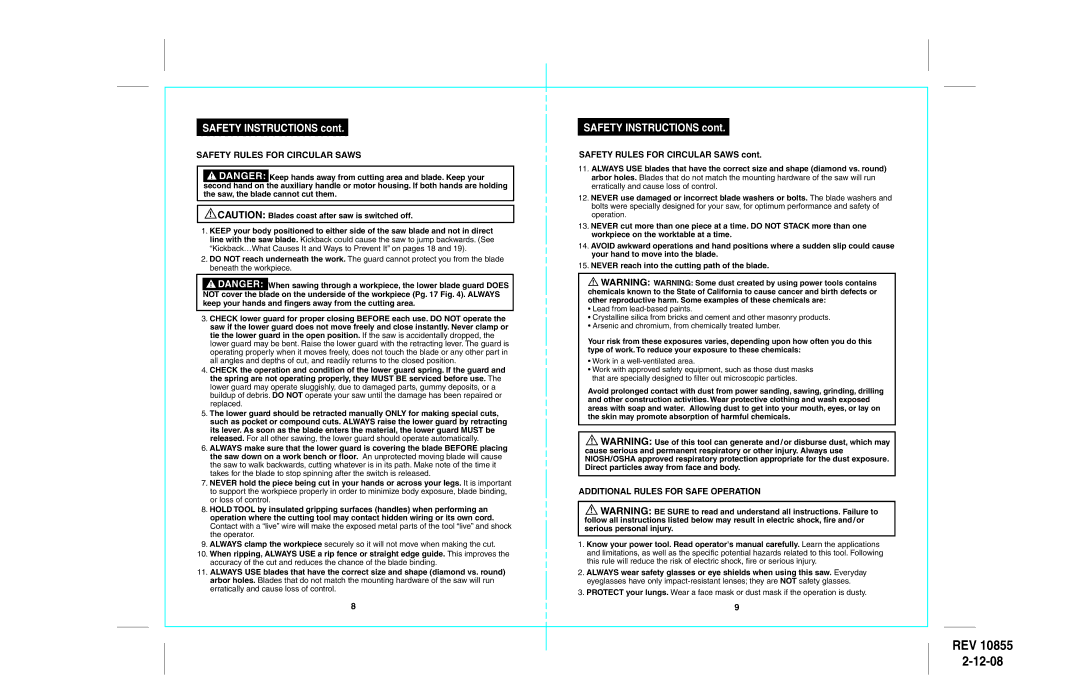SAFETY INSTRUCTIONS cont.
SAFETY RULES FOR CIRCULAR SAWS
!DANGER: Keep hands away from cutting area and blade. Keep your second hand on the auxiliary handle or motor housing. If both hands are holding the saw, the blade cannot cut them.
!CAUTION: Blades coast after saw is switched off.
1.KEEP your body positioned to either side of the saw blade and not in direct line with the saw blade. Kickback could cause the saw to jump backwards. (See “Kickback…What Causes It and Ways to Prevent It” on pages 18 and 19).
2.DO NOT reach underneath the work. The guard cannot protect you from the blade beneath the workpiece.
!DANGER: When sawing through a workpiece, the lower blade guard DOES NOT cover the blade on the underside of the workpiece (Pg. 17 Fig. 4). ALWAYS keep your hands and fingers away from the cutting area.
3.CHECK lower guard for proper closing BEFORE each use. DO NOT operate the saw if the lower guard does not move freely and close instantly. Never clamp or tie the lower guard in the open position. If the saw is accidentally dropped, the lower guard may be bent. Raise the lower guard with the retracting lever. The guard is operating properly when it moves freely, does not touch the blade or any other part in all angles and depths of cut, and readily returns to the closed position.
4.CHECK the operation and condition of the lower guard spring. If the guard and the spring are not operating properly, they MUST BE serviced before use. The lower guard may operate sluggishly, due to damaged parts, gummy deposits, or a buildup of debris. DO NOT operate your saw until the damage has been repaired or replaced.
5.The lower guard should be retracted manually ONLY for making special cuts, such as pocket or compound cuts. ALWAYS raise the lower guard by retracting its lever. As soon as the blade enters the material, the lower guard MUST be released. For all other sawing, the lower guard should operate automatically.
6.ALWAYS make sure that the lower guard is covering the blade BEFORE placing the saw down on a work bench or floor. An unprotected moving blade will cause the saw to walk backwards, cutting whatever is in its path. Make note of the time it takes for the blade to stop spinning after the switch is released.
7.NEVER hold the piece being cut in your hands or across your legs. It is important to support the workpiece properly in order to minimize body exposure, blade binding, or loss of control.
8.HOLD TOOL by insulated gripping surfaces (handles) when performing an operation where the cutting tool may contact hidden wiring or its own cord. Contact with a “live” wire will make the exposed metal parts of the tool “live” and shock the operator.
9.ALWAYS clamp the workpiece securely so it will not move when making the cut.
10.When ripping, ALWAYS USE a rip fence or straight edge guide. This improves the accuracy of the cut and reduces the chance of the blade binding.
11.ALWAYS USE blades that have the correct size and shape (diamond vs. round) arbor holes. Blades that do not match the mounting hardware of the saw will run erratically and cause loss of control.
8
SAFETY INSTRUCTIONS cont.
SAFETY RULES FOR CIRCULAR SAWS cont.
11.ALWAYS USE blades that have the correct size and shape (diamond vs. round) arbor holes. Blades that do not match the mounting hardware of the saw will run erratically and cause loss of control.
12.NEVER use damaged or incorrect blade washers or bolts. The blade washers and bolts were specially designed for your saw, for optimum performance and safety of operation.
13.NEVER cut more than one piece at a time. DO NOT STACK more than one workpiece on the worktable at a time.
14.AVOID awkward operations and hand positions where a sudden slip could cause your hand to move into the blade.
15.NEVER reach into the cutting path of the blade.
!WARNING: WARNING: Some dust created by using power tools contains chemicals known to the State of California to cause cancer and birth defects or other reproductive harm. Some examples of these chemicals are:
•Lead from lead-based paints.
•Crystalline silica from bricks and cement and other masonry products.
•Arsenic and chromium, from chemically treated lumber.
Your risk from these exposures varies, depending upon how often you do this type of work. To reduce your exposure to these chemicals:
•Work in a well-ventilated area.
•Work with approved safety equipment, such as those dust masks that are specially designed to filter out microscopic particles.
Avoid prolonged contact with dust from power sanding, sawing, grinding, drilling and other construction activities. Wear protective clothing and wash exposed areas with soap and water. Allowing dust to get into your mouth, eyes, or lay on the skin may promote absorption of harmful chemicals.
!WARNING: Use of this tool can generate and /or disburse dust, which may cause serious and permanent respiratory or other injury. Always use NIOSH/OSHA approved respiratory protection appropriate for the dust exposure. Direct particles away from face and body.
ADDITIONAL RULES FOR SAFE OPERATION
!WARNING: BE SURE to read and understand all instructions. Failure to follow all instructions listed below may result in electric shock, fire and/or serious personal injury.
1.Know your power tool. Read operator's manual carefully. Learn the applications and limitations, as well as the specific potential hazards related to this tool. Following this rule will reduce the risk of electric shock, fire or serious injury.
2.ALWAYS wear safety glasses or eye shields when using this saw. Everyday eyeglasses have only impact-resistant lenses; they are NOT safety glasses.
3.PROTECT your lungs. Wear a face mask or dust mask if the operation is dusty.
9

